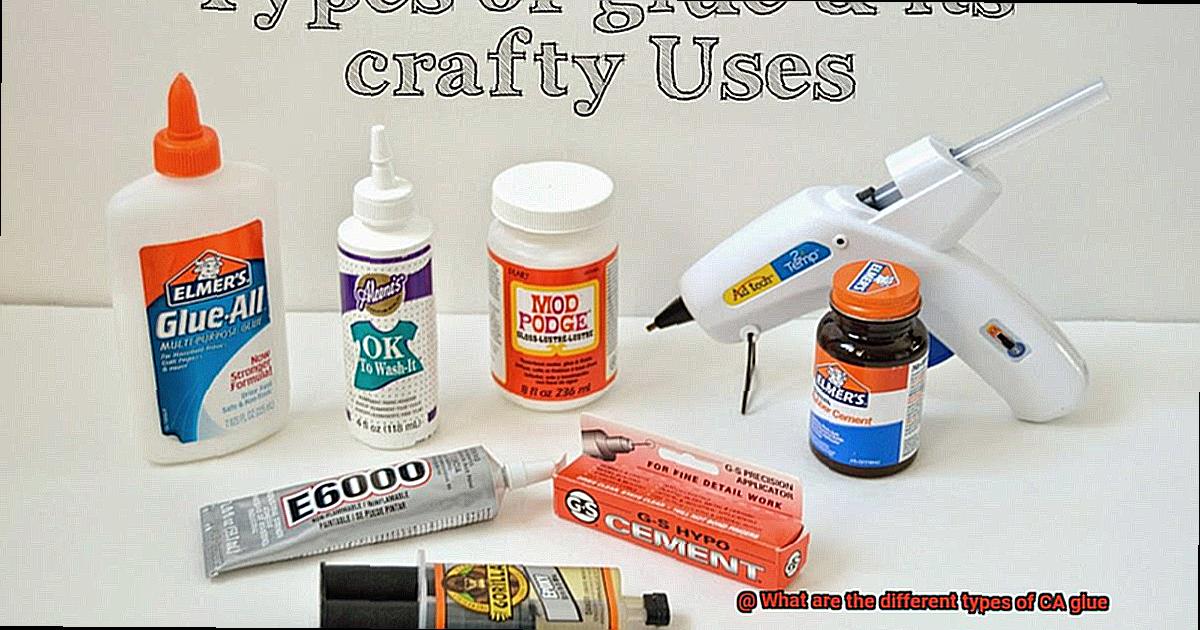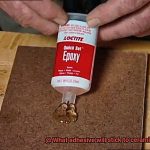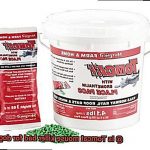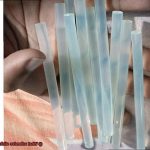Looking for the perfect adhesive to secure your projects?
Say hello to CA glue, the DIY enthusiast’s best friend. This amazing glue, also known as cyanoacrylate adhesive, is a favorite among hobbyists, woodworkers, and even medical professionals.
But with so many types of CA glue out there, how do you choose the right one? Don’t worry – in this blog post, we’ll break it down for you.
We’ll explore thin, medium, and thick viscosity options, as well as gel and odorless varieties. By the end of this post, you’ll be armed with all the knowledge you need to make an informed decision for your next project.
Let’s get started.
What is CA Glue?
Contents
When it comes to adhesive solutions, one name stands out among the rest – CA glue, also known as cyanoacrylate adhesive. This versatile glue has become a staple in the toolboxes of craftsmen, hobbyists, and professionals alike. In this article, we will explore the world of CA glue, its quick bonding capabilities, various viscosities, specialized formulations, and packaging options that make it an essential tool for a wide range of applications.
Quick Bonding Capabilities:
CA glue sets itself apart from traditional adhesives with its lightning-fast bonding capabilities. While other adhesives may take hours or even days to fully cure, CA glue forms a strong bond within seconds. This makes it ideal for situations where time is of the essence, such as in woodworking projects or quick repairs.
Different Viscosities for Different Applications:
CA glue is available in various viscosities or thicknesses, allowing users to choose the right type for their specific needs. Thin CA glue flows easily and penetrates into tight gaps and cracks, making it perfect for bonding small parts or repairing delicate objects. Medium viscosity CA glue strikes a balance between flowability and gap-filling properties, making it a versatile option for a wide range of applications. Thick CA glue has a gel-like consistency that stays in place without running or dripping, making it suitable for bonding porous materials or filling larger gaps.
Specialized Formulations:
In addition to different viscosities, there are specialized formulations of CA glue designed for specific purposes. Odorless CA glues are available for those who are sensitive to strong smells, providing the same fast-bonding capabilities without the unpleasant fumes. Some CA glues are formulated specifically for bonding plastics, while others work well with metals, ceramics, rubber, or wood. Choosing the right formula ensures optimal results for your specific project.
Packaging Options:
CA glue can be found in various packaging options, such as bottles with brush applicators or precision tips. The brush applicators allow for easy and controlled application, while precision tips enable precise placement in hard-to-reach areas. The choice of packaging depends on the intended use and personal preference.
Types of CA Glue
Let’s dive in and explore the unique properties and characteristics of each type.

Thin CA Glue:
Thin CA glue, also known as thin viscosity glue, is like a superhero glue for quick fixes and precision work. With its watery consistency, it easily seeps into tiny crevices and forms a strong bond in seconds. It is perfect for bonding materials with tight fits, such as wood joints or small cracks. When you need a glue that can reach those hard-to-reach places and dry in an instant, thin CA glue is your go-to adhesive.
Medium CA Glue:
Slightly thicker than thin glue, medium CA glue strikes a balance between flowability and gap-filling ability. It provides strength and flexibility in one neat package, making it great for bonding porous materials like leather or foam. Whether you’re working on upholstery repairs or crafting foam props, medium CA glue will ensure a durable bond without compromising on flexibility.
Thick CA Glue:
For larger gaps or uneven surfaces, thick CA glue comes to the rescue. Its gel-like consistency stays put, making it ideal for vertical applications or when you need more time for adjustments before it fully cures. Thick CA glue is perfect for filling gaps in woodworking projects or bonding porous materials that require extra support. When it comes to providing strength and stability to your projects, thick CA glue has got you covered.
Accelerator or Activator:
Need speed? Accelerators or activators are your secret weapons. These products work hand in hand with CA glue to speed up the curing process, reducing drying time significantly. Simply apply the accelerator to one surface and the CA glue to the other, press them together, and watch the bond form instantly. Accelerators are perfect for those moments when you need instant results or are working on time-sensitive projects.
Specialized Formulations:
The world of CA glue doesn’t stop at viscosity. Specialized formulations cater to specific needs. Rubber-toughened CA glue adds flexibility and strength to bond rubber or plastic parts, making it ideal for repairing shoes or sealing rubber gaskets. Foam-safe CA glue delicately bonds foam materials without damage, ensuring a secure bond without melting or dissolving the foam. Heat-resistant CA glue can withstand high temperatures, making it suitable for projects that require durability in hot environments, such as automotive repairs or electronics assembly.
Thin CA Glue
Thin CA glue, also known as cyanoacrylate glue, is a remarkable adhesive that offers a range of advantages for various applications. This adhesive’s low viscosity allows it to flow smoothly into tight spaces and small cracks, ensuring a secure bond. Thin CA glue is celebrated for its quick-curing properties, forming a strong bond within seconds. It is highly versatile, capable of bonding materials like wood, metal, plastic, rubber, and ceramics, making it an excellent choice for a wide range of projects.
The advantages of thin CA glue are numerous. First and foremost, its quick bonding abilities make it invaluable when time is of the essence. Whether you’re repairing a broken piece of jewelry or working on a time-sensitive project, thin CA glue offers rapid results. Additionally, its ability to penetrate into tight spaces ensures precise application and reliable repairs. This makes it ideal for delicate woodworking projects or fixing fragile items.

Furthermore, thin CA glue boasts impressive strength and durability once fully cured. It forms a bond that can withstand significant stress and strain, providing long-lasting results. Its reliability makes it suitable for repairs that require durability and resilience.
While thin CA glue offers many advantages, it’s important to consider its limitations as well. Due to its low viscosity, it may not be the best choice for filling larger gaps or uneven surfaces. In these cases, thicker versions of CA glue or other types of adhesives may be more appropriate. Thin CA glue can also run easily if not applied carefully, potentially creating a mess. Therefore, it’s important to exercise caution when using this adhesive and work in well-ventilated areas.
Additionally, thin CA glue has a relatively short shelf life once opened. It is crucial to check the expiration date and discard any old or expired glue to ensure optimal performance. Furthermore, thin CA glue may not perform well in humid or moist environments, as moisture can interfere with the curing process. It is best to ensure the surface is dry before applying the glue.
Finally, it is worth noting that thin CA glue, like all cyanoacrylate glues, can cause skin irritation and adhere to surfaces. Wearing gloves and taking necessary precautions is crucial when using this adhesive to avoid any potential skin contact.
Medium CA Glue
Medium CA glue, also known as medium viscosity cyanoacrylate adhesive, is a versatile and reliable adhesive that strikes the perfect balance between thin and thick viscosity. It is a go-to superhero adhesive for all your crafting and DIY projects.
One of the key advantages of medium CA glue is its ability to bond different materials effectively. Whether you’re working with wood, metal, plastic, rubber, or ceramics, this glue will create a strong and durable bond. Its versatility knows no bounds.
In terms of consistency, medium CA glue has a slightly thicker viscosity compared to its thin counterpart. This means you have more control during application, making it easier to bond smaller parts or intricate details. Additionally, its slightly thicker consistency allows it to fill in small gaps or uneven surfaces for an even stronger bond. It’s like having a trusty sidekick that helps you overcome any obstacles in your crafting journey.
Speed is also a superpower of medium CA glue. While it may not set as quickly as thin CA glue, it still dries rapidly compared to other types of adhesives. This means you don’t have to sit around waiting for the glue to fully cure before moving on to the next step of your project. It’s perfect for those times when you need to get things done in a jiffy.
However, it’s important to remember that safety comes first when using medium CA glue. The curing process releases fumes that can irritate your eyes and respiratory system, so it’s crucial to work in a well-ventilated area or wear protective gear like goggles and a mask.
Thick CA Glue
This adhesive has a thicker consistency compared to standard CA glue, making it perfect for woodworking projects and repairs. Let’s explore the benefits of using thick CA glue and why it should be a staple in your toolkit.
Bridging Gaps:
Thick CA glue has the remarkable ability to fill gaps and bond uneven surfaces effortlessly. Whether you’re fixing a broken chair or creating intricate woodwork, this adhesive will ensure a strong and seamless connection. No more struggling with weak bonds – thick CA glue has got you covered.
Extended Working Time:
Say goodbye to rushed projects. Thick CA glue offers a slower curing time, giving you ample time to position and align your materials before it sets. No more panicking or rushing – take your time to get everything just right. With thick CA glue, precision and perfection are within reach.
Strength and Durability:
Don’t underestimate the power of thick CA glue. Once cured, it forms a rock-solid bond that can withstand impacts and stresses. It is perfect for structural applications where strength and stability are essential. Whether you’re building furniture or repairing delicate objects, thick CA glue provides the strength and durability you need.
Versatility and Reliability:
Thick CA glue is an all-rounder that thrives in any environment. It can handle temperature fluctuations, humidity, and even chemical exposure. Some formulations are even moisture-resistant, making them ideal for demanding environments. With thick CA glue, you can trust that your projects will hold up under any conditions.
Ease of Application:
Thick CA glue comes in various sizes, allowing you to choose the perfect amount for your project. With applicator tips or brushes, precise application is a breeze. No more messy drips or wasted glue. Just be sure to store it properly for extended shelf life, and you’ll have a reliable adhesive at your fingertips whenever you need it.
Accelerator or Activator
CA glue, known for its unparalleled strength and versatility, can be taken to new heights with the secret ingredients of accelerators or activators. These unsung heroes of the adhesive world possess the ability to supercharge your bonding power. In this article, we will delve into the distinctions between accelerators and activators, exploring their role in enhancing CA glue performance.
Rapid Curing Process:
Accelerators or activators excel in expediting the curing process of CA glue. While CA glue already boasts quick bonding capabilities, accelerators elevate it to another level. By initiating a reaction with cyanoacrylate molecules, accelerators accelerate polymerization, resulting in a robust bond within a fraction of the time.
Versatile Application Options:
Accelerators come in diverse forms, catering to various application needs. Aerosol accelerators, available in convenient spray cans, enable effortless and precise application. A simple spritz on the glued surface is all it takes to stimulate rapid bonding. Alternatively, brush-on accelerators offer controlled and targeted application, making them perfect for intricate or small-scale projects.
Specialized Formulations for Porous Materials:
Certain accelerators are specially formulated for porous materials like wood or fabric. These specialized variants penetrate deep into the material, ensuring swift bonding while minimizing surface staining risks. They prove invaluable for projects that require complete glue absorption.
Cautionary Usage and Adherence to Instructions:
While accelerators work wonders, it is vital to exercise caution and adhere to manufacturer instructions. Excessive usage can result in brittle bonds or unsightly discoloration. Conducting a small-scale test before applying them to the entire project is essential.
Specialized Formulations
A seemingly simple word that unlocks a world of endless possibilities. Whether you’re an avid crafter, a DIY enthusiast, or simply someone who wants to fix things around the house, glue is an essential tool in your arsenal. But did you know that there are specialized formulations of glue that cater to specific applications and requirements? Let’s dive into the captivating realm of specialized CA glue formulations and discover their unique uses.
First in line is the remarkable gap-filling CA glue. With its thicker consistency, it effortlessly bridges the divide between uneven surfaces or large gaps. Say farewell to unsightly cracks and uneven joins, for this specialized formulation ensures a seamless bond every single time.
Next on our remarkable list is the low-odor CA glue. We all know that traditional CA glues can release a pungent smell, but fear not. The low-odor formulation has been skillfully crafted to minimize that potent odor, making it more comfortable for those who are sensitive to smells or find themselves working in confined spaces.
Flexibility becomes paramount in certain applications, and that’s where the extraordinary flexible CA glue comes into play. This specialized formulation retains a touch of flexibility even after curing, making it the perfect adhesive for materials that may experience slight movement or vibrations.
Crafters and model-builders rejoice, for we present to you the indispensable foam-safe CA glue. This marvel of a formulation has been expertly designed to be used on foam materials without causing any damage or melting. So unleash your creativity without fear of ruining your cherished foam creations.
When it comes to withstanding extreme temperatures, the resilient heat-resistant CA glue takes center stage. This specialized formulation fearlessly endures high temperatures while retaining its adhesive properties, making it ideal for bonding heat-sensitive electronic components or tackling rugged automotive repairs.
For those embarking on outdoor projects or anticipating water exposure, the steadfast water-resistant CA glue becomes your trusty comrade. Formulated to provide a robust bond even in the face of moisture or water, it guarantees that your projects stay intact regardless of the weather conditions.
And for those who simply can’t bear the overpowering scent of traditional CA glues, behold the game-changing odorless CA glue. This specialized formulation banishes the strong smell, making it a joy to work with for extended periods.
Last but certainly not least, we present to you the captivating colored CA glue. Available in an array of vibrant shades, this specialized formulation is often used for aesthetic purposes or to flawlessly match the color of the materials being bonded. So let your creativity shine and bask in the brilliance of colored CA glue.
Safety Precautions
As you embark on your adhesive journey, it is crucial to prioritize safety to ensure a hassle-free experience. In this article, we will explore the essential safety precautions to follow when using CA glue, empowering you to unleash its power while keeping yourself protected.
Protecting Your Skin:
- Shield your hands with nitrile gloves: These offer a powerful barrier against the glue, allowing you to handle it with dexterity and sensitivity.
- Avoid skin contact: If any glue comes into contact with your skin, swiftly wash your hands to prevent irritation or burns.
Shielding Your Eyes:
- Don safety goggles or glasses: These will be your trusty shields against potential harm caused by fumes or accidental splashes.
- Eye contact precaution: In case of accidental eye contact, immediately flush your eyes with clean water for at least 15 minutes. Seek medical attention if necessary.
Ensuring Proper Ventilation:
- Breathe in fresh air: Choose a well-ventilated work area with open windows or an exhaust fan to minimize inhalation risks.
- Fume extraction for indoor projects: Consider using a portable fume extractor or wearing a respirator mask designed for organic vapors.
Proper Storage:
- Keep it cool and dry: Store the glue away from direct sunlight or heat sources to prevent deterioration or potential explosions.
- Seal it tightly: Ensure the container is tightly closed when not in use to avoid accidental spills or leaks.
- Check expiration date: Verify the glue’s effectiveness by checking its expiration date before use.
Handling Flammability:
- Keep away from fire sources: CA glue is highly flammable, so steer clear of open flames or high temperatures.
- Allow complete drying before applying heat: Ensure the glue is fully dry before exposing it to heat or flame to prevent combustion.
mYxLPkve6rI” >
Conclusion
When it comes to CA glue, there are several different types available on the market. Each type has its own unique characteristics and uses, making it important to understand the differences between them.
Firstly, there is thin CA glue. As the name suggests, this type of glue has a watery consistency and is perfect for bonding materials that require precise application or have tight-fitting joints. It sets quickly and creates a strong bond, making it ideal for woodworking projects or repairing delicate items.
Next up is medium CA glue. This type of glue has a slightly thicker consistency compared to thin CA glue, allowing for better gap filling capabilities. It still sets relatively fast but provides a bit more working time than the thin variety. Medium CA glue is commonly used in general woodworking tasks or when bonding materials with small gaps or uneven surfaces.
For those who need an even thicker adhesive, there is thick CA glue. This type of glue has a syrupy consistency and is excellent for bonding porous materials or filling larger gaps. It takes longer to set compared to thin and medium CA glues, giving you ample time to position your pieces before the bond becomes permanent.
In addition to these basic types, there are also specialized variations of CA glue available. For instance, there are rubber-toughened CA glues that offer increased flexibility and impact resistance once cured. These are often used in applications where vibration or movement may be present.
Furthermore, some CA glues come in gel form. Gel CA glues have a non-drip formula that allows for vertical applications without any mess or runny residue. They are great for projects where precision and control are crucial.
Lastly, there are odorless versions of CA glue for those who prefer working with minimal fumes and odors.
In conclusion, understanding the different types of CA glue can help you choose the most suitable one for your specific project needs. Whether you’re working on delicate crafts or heavy-duty repairs, there is a CA glue out there that will provide the perfect bond.






